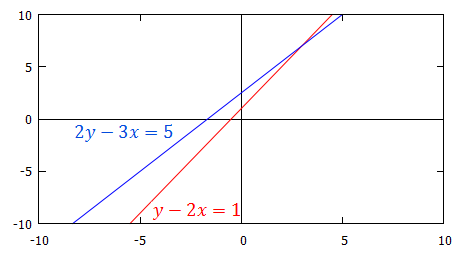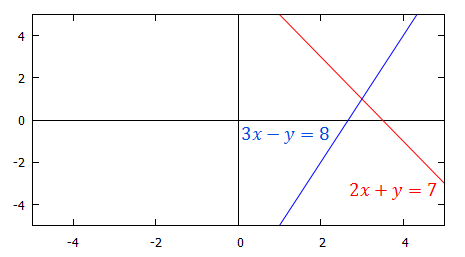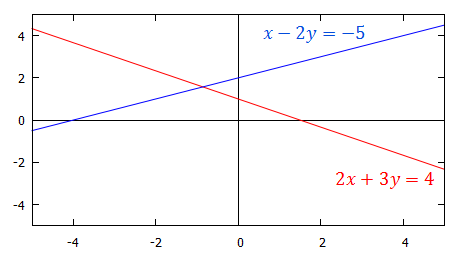Simultaneous Equations
Solving Simultaneous Linear Equations
Two or more linear equations that all contain the same unknown variables are called a system of simultaneous linear equations. To solve such a system, we must find values for the unknown variables which satisfy all the equations at the same time.
There are two common methods for solving simultaneous linear equations: substitution and elimination. In some questions, one method is the more obvious choice, often because it makes the process of solving the equations simpler; in others, the choice of method is up to personal preference. In either case, both methods would eventually lead to the same solution.
Note:To be able to solve any system of linear equations we must have at least as many equations as we have variables.
Substitution
The substitution method involves rearranging one of the equations so that is it in a form which can easily be substituted into the other equation.
Worked Examples
Example 1
Solve this pair of linear simultaneous equations
Solution
It's a good idea to label the equations so they're easier to refer to.
Rearrange equation 1 and make the subject.
Substitute this expression for into equation 2.
Now we have an equation in only one variable, which can be rearranged and solved to find .
Now we have a value for , this can be substituted into either of the original equations to find . It's easiest to use the rearranged expression for we derived from equation 1.
The solution and satisfies both equations. It's a good idea to check your solution by substituting these values of and into the original equations.

|center
This graph shows the lines and . The solution to these simultaneous equations is the point at which the two lines intersect. We can see that this is the point (3,7) which agrees with our solution.
Example 2
Solve this system of three simultaneous linear equations.
Solution
Label the equations 1, 2 and 3, respectively.
Rearrange equation 1 to make the subject.
Substitute this expression for into equations 2 and 3.
Equation 2 becomes
And equation 3 becomes
Now we only have two equations and two unknowns so we can solve as in the last example.
Rearrange equation 2* to make the subject.
Substitute this into 3*
Now substitute this value for into 2* to give
Now we know the values of two of the variables, we can substitute these both back into equation 1 to find .
We have found that the solution to the system of simultaneous equations is , and .
Video Example
Prof. Robin Johnson uses the substitution method to solve the simultaneous equations and .
Elimination
Definition
When given two simultaneous linear equations with two unknowns, we can also apply the elimination method. The elimination method involves choosing a variable to eliminate.
Start by multiplying both equations by appropriate constants so that in each equation the chosen variable has the same coefficient (disregarding its sign).
Then, depending on the sign in front of the variable, either add or subtract one equation from the other so that the terms involving the variable to be eliminated cancel out.
The remaining equation is in one variable, and can be solved in the usual way; the value of that variable is then substituted into one of the original equations to find the value of the eliminated variable.
Worked Examples
Example 1
Solve the simultaneous linear equations
Solution
Notice here that the coefficient of is the same up to sign in both of the equations. As one is positive and one is negative, if we add the two equations together, the 's will cancel.
So .
Now substitute this value for back into one of the original equations.
The values , satisfy both of the equations we were given.

|center
This graph shows the lines and . The solution to these simultaneous equations is the point at which the two lines intersect. We can see that this is the point (3,1) which agrees with our solution.
Example 2
Solve this system of two simultaneous linear equations.
Solution
Label the equations 1 and 2, respectively.
We want to make the coefficients of the same in both equations. To do this, multiply equation (2) by .
As the coefficients of in both equations are positive, we subtract equation 2 from equation 1.
So .
Substituting this value for back into one of the original equations will give .
The values and satisfy both of the equations we were given.

|center
This graph shows the lines and . The solution to these simultaneous equations is the point at which the two lines intersect.
Video Example
Prof. Robin Johnson solves the simultaneous equations and using the elimination method.
Workbook
This workbook produced by HELM is a good revision aid, containing key points for revision and many worked examples.
Test Yourself
Test yourself: Numbas test on simultaneous equations
External Resources
- Simultaneous linear equations workbook at mathcentre.
- Systems of Linear Equations by Maths is Fun